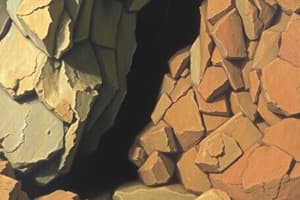Podcast
Questions and Answers
What is the primary process responsible for the formation of sedimentary rocks?
What is the primary process responsible for the formation of sedimentary rocks?
- Sedimentation (correct)
- Metamorphism
- Volcanic eruption
- Tectonic plate movement
Which of the following is NOT a characteristic of clastic sedimentary rocks?
Which of the following is NOT a characteristic of clastic sedimentary rocks?
- Formed through chemical precipitation (correct)
- Can include conglomerates, breccias, and sandstones
- Composed of fragments of pre-existing rocks
- Categorized based on average clast diameter
Which of the following is an example of a chemical sedimentary rock?
Which of the following is an example of a chemical sedimentary rock?
- Sandstone
- Shale
- Conglomerate
- Limestone (correct)
Which of the following agents is LEAST likely to be involved in the transportation of particles during the sedimentation process?
Which of the following agents is LEAST likely to be involved in the transportation of particles during the sedimentation process?
Which of the following best describes the formation of metamorphic rocks?
Which of the following best describes the formation of metamorphic rocks?
Which of the following is a key characteristic of igneous rocks?
Which of the following is a key characteristic of igneous rocks?
What is the primary characteristic that distinguishes sedimentary rocks from other rock types?
What is the primary characteristic that distinguishes sedimentary rocks from other rock types?
Which of the following is an example of an orthochemical sedimentary rock?
Which of the following is an example of an orthochemical sedimentary rock?
Which of the following factors determines whether an igneous rock is classified as mafic or felsic?
Which of the following factors determines whether an igneous rock is classified as mafic or felsic?
Which of the following is an example of a felsic igneous rock?
Which of the following is an example of a felsic igneous rock?
How are metamorphic rocks formed?
How are metamorphic rocks formed?
Which of the following is an example of a metamorphic rock and the parent rock from which it is derived?
Which of the following is an example of a metamorphic rock and the parent rock from which it is derived?
Flashcards are hidden until you start studying
Study Notes
Rocks: A Comprehensive Overview
Introduction
Rocks are an essential component of the earth's crust and play vital roles in various aspects of human life. They are classified into three primary categories: sedimentary, igneous, and metamorphic, each with distinct characteristics and formation processes. In this article, we will delve into the formation and properties of these rock types.
Sedimentary Rock Formation
Sedimentary rocks are formed through the accumulation or deposition of mineral or organic particles on Earth's surface followed by cementation. This process is known as sedimentation and includes the transportation of particles to the site of deposition by agents such as water, wind, mass movement, or ice. Examples of sedimentary rocks include sandstone, shale, limestone, chalk, and conglomerate. These rocks often form layers called strata, which can provide valuable information about the subsurface and geological history.
Clastic Sedimentary Rocks
Clastic sedimentary rocks are composed of fragments of pre-existing rocks or pieces of once-living organisms. They are categorized based on average clast diameter, with coarse materials forming conglomerates and breccias, medium-grained material becoming sandstones, and fine materials like silt and clay transforming into siltstone, claystone, mudrock, and shale.
Chemical Sedimentary Rocks
Chemical sedimentary rocks originate from chemical precipitation of dissolved products of weathering and biological activity. They consist of solid precipitated particles that undergo a brief history of transport and abrasion prior to becoming sedimentary rock. Some examples include limestones made of calcium carbonate shell fragments or concentrically layered spherical grains called oöids, and orthochemical deposits like bedded evaporite deposits of halite, gypsum, anhydrite, or banded iron formations.
Igneous Rock Formation
Igneous rocks are formed from melted rock or magma, which cools and solidifies over time. These rocks can form either intrusively, when magma cools underground, creating plutons and batholiths, or extrusively, when magma flows onto the Earth's surface and cools quickly, generating volcanic rocks like basalt, andesite, rhyolite, and obsidian.
Types of Igneous Rocks
Igneous rocks can be further divided into two broad categories: mafic (high iron and magnesium content) and felsic (low iron and magnesium content). Mafic rocks, such as basalt, are typically dark colored and fine-grained, while felsic rocks, such as granite, are lighter colored and coarser grained. There are also intermediate igneous rocks that exhibit characteristics between mafic and felsic rocks, such as andesite and diorite.
Metamorphic Rock Formation
Metamorphic rocks develop from pre-existing rocks that undergo changes due to heat, pressure, or chemically active fluids. As a result, the original rock experiences recrystallization, causing it to form new minerals and textures. Common examples of metamorphic rocks include marble from limestone, quartzite from sandstone, and gneiss from schist or hornfels from basic igneous or metamorphic rocks.
In conclusion, rocks play a crucial role in shaping the earth's landscape and providing valuable resources for human civilization. Understanding the formation and classification of sedimentary, igneous, and metamorphic rocks enables us to appreciate the complex geologic processes that shape our planet.
Studying That Suits You
Use AI to generate personalized quizzes and flashcards to suit your learning preferences.




